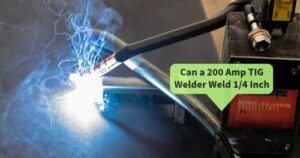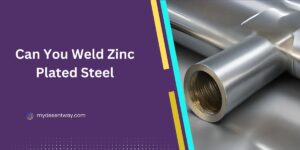Table of Contents
- Understanding TIG Welding
- The Power of a 200 Amp TIG Welder
- Welding 1/4″ Materials with a 200 Amp TIG Welder
- Achieving Optimal Results
- Advanced Techniques for Welding with a 200 Amp TIG Welder
- Pulse Welding for Precision
- Tungsten Preparation and Geometry
- Back Purging for Clean Welds
- Utilizing Filler Metal
- Employing Proper Joint Preparation
- The Importance of Welding Safety and Maintenance
- Prioritizing Welding Safety
- Maintaining Your 200 Amp TIG Welder
- Exploring TIG Welding Parameters for Different Steel Thicknesses
- Amperage for 1/4 Inch Steel
- Welder Size for 1/4 Inch Steel
- Maximum Weld Thickness with 200 Amps
- Minimum Thickness for TIG Welding
- Conclusion
- FAQs
- Q1: Can a 200 Amp TIG welder be used for thinner materials as well?
- Q2: What type of gas is typically used for TIG welding?
- Q3: Are there any safety precautions to consider while TIG welding?
- Q4: Can I weld different types of metals with a 200 Amp TIG welder?
- Q5: Where can I find more welding tips and tutorials?
When it comes to welding, the capabilities of different welding machines are often a topic of discussion. One common question that arises is whether a 200 Amp TIG welder can effectively handle welding tasks involving materials as thick as 1/4″. In this article, we’ll delve into the details of TIG welding, explore the capabilities of a 200 Amp TIG welder, and provide insights into welding 1/4″ materials.
Understanding TIG Welding
Tungsten Inert Gas (TIG) welding, also known as Gas Tungsten Arc Welding (GTAW), is a versatile and precise welding process. It utilizes a non-consumable tungsten electrode to create the arc and requires a separate filler material for the welding joint. TIG welding is renowned for its ability to create high-quality welds with excellent aesthetics and minimal spatter. This process is commonly used in industries where precision and clean welds are paramount.
The Power of a 200 Amp TIG Welder
A TIG welder’s amperage rating is a crucial factor that determines its welding capabilities. A 200 Amp TIG welder offers a substantial amount of power, making it suitable for welding a wide range of materials and thicknesses. The amperage directly impacts the heat generated by the welding arc, allowing for deeper penetration and faster welding speeds. However, the question remains: can it effectively weld 1/4″ materials?
Welding 1/4″ Materials with a 200 Amp TIG Welder
Welding materials that are 1/4″ thick require a welder with sufficient power and heat control. A 200 Amp TIG welder is generally up to the task, but there are several factors to consider. One must ensure that the welder is equipped with the appropriate settings and a high-quality tungsten electrode. Additionally, the choice of filler material and gas selection are crucial for achieving strong and durable welds.
Achieving Optimal Results
To achieve optimal results when welding 1/4″ materials with a 200 Amp TIG welder, it’s essential to follow these steps:
1. Select the Right Tungsten Electrode
Choosing the right tungsten electrode is vital. Thoriated tungsten electrodes are commonly used for thicker materials as they can handle higher amperages without prematurely wearing out.
2. Adjusting Amperage and Gas Flow
Set the amperage within the appropriate range for welding 1/4″ materials. Additionally, ensure the gas flow rate is sufficient to protect the weld zone from oxidation.
3. Preparation and Fit-up
Properly prepare the materials by cleaning and beveling the edges for optimal joint penetration. A precise fit-up ensures a strong and uniform weld.
4. Practice and Technique
Practice your welding technique on scrap materials of the same thickness before starting the actual weld. Maintain a consistent travel speed and torch angle for even bead formation.
Advanced Techniques for Welding with a 200 Amp TIG Welder
In the world of welding, mastering advanced techniques can take your skills to the next level. In this section, we will explore some advanced tips and tricks for welding with a 200 Amp TIG welder, particularly when dealing with 1/4″ materials.
Pulse Welding for Precision
Pulse welding is a technique that involves alternating between high and low current levels during the welding process. This technique is particularly useful when working with thicker materials. By pulsing the current, you can control the heat input more precisely, reducing the risk of overheating the material. This results in a finer bead appearance and less distortion, making it ideal for projects that demand both precision and strength.
Tungsten Preparation and Geometry
The geometry of the tungsten electrode plays a crucial role in the welding process. For welding thicker materials, consider using a larger diameter tungsten electrode. Additionally, taper the electrode to a fine point. This finer point helps direct the heat to a smaller area, allowing for better arc control and penetration. Properly prepared tungsten electrodes contribute to cleaner welds and minimize contamination.
Back Purging for Clean Welds
When welding materials that are 1/4″ thick, achieving clean and strong welds on both sides of the joint can be a challenge. Back purging is a technique that involves introducing inert gas to the backside of the weld joint. This prevents oxidation and contamination on the backside, resulting in welds that are not only aesthetically pleasing but also structurally sound. Back purging is especially important when working with materials like stainless steel, where the backside can be prone to sugaring.
Utilizing Filler Metal
Choosing the right filler metal is essential for achieving high-quality welds. When welding 1/4″ materials, consider using a filler metal that matches the base material or is specifically designed for the material you’re working with. Proper filler metal selection ensures compatibility and helps maintain the desired mechanical properties of the joint.
Employing Proper Joint Preparation
The quality of a weld joint has a significant impact on the overall strength and integrity of the weld. For welding 1/4″ materials, consider using joint designs that allow for deeper penetration. Beveling the edges of the materials creates a V-groove or U-groove joint, allowing the filler metal to penetrate deeper and create a stronger bond.
The Importance of Welding Safety and Maintenance
Ensuring safety during welding operations and maintaining your welding equipment are paramount considerations for every welder. In this section, we’ll discuss the critical aspects of welding safety and the maintenance routines that will keep your 200 Amp TIG welder in top-notch condition.
Prioritizing Welding Safety
Welding involves various hazards, including intense heat, bright arcs, and potentially harmful fumes. Prioritizing safety is non-negotiable. Here are some safety measures to adhere to:
1. Protective Gear
Wear appropriate welding safety gear, including a welding helmet with a shade suitable for the welding process, flame-resistant clothing, welding gloves, and safety boots. Protecting your skin and eyes from UV radiation and sparks is crucial.
2. Ventilation
Welding generates fumes and gases that can be harmful if inhaled. Ensure you’re working in a well-ventilated area, and if indoors, consider using exhaust fans or extraction systems to remove fumes from your workspace.
3. Fire Prevention
Keep a fire extinguisher nearby at all times. Welding sparks can easily ignite flammable materials, so clear the area of any combustibles before starting.
4. Grounding
Properly ground your workpiece and welding equipment to prevent electric shock and reduce the risk of arc flash.
Maintaining Your 200 Amp TIG Welder
Regular maintenance prolongs the lifespan of your welding equipment and ensures consistent performance. Here’s how to keep your 200 Amp TIG welder in optimal shape:
1. Cleanliness
Regularly clean your welder to prevent dust and debris from accumulating. Dust can obstruct airflow, leading to overheating of components.
2. Electrode and Nozzle Inspection
Inspect and replace the tungsten electrode when it becomes worn or contaminated. Also, regularly check the nozzle for any signs of damage or blockage.
3. Cooling System
If your TIG welder has a cooling system, ensure that it’s functioning correctly. A well-maintained cooling system prevents overheating during prolonged welding sessions.
4. Cable Check
Inspect the cables and connections for signs of wear or damage. Damaged cables can affect the flow of current and lead to inconsistent welds.
5. Gas Supply
Monitor the gas supply to ensure a steady flow of shielding gas. Inconsistent gas flow can lead to porosity in the weld.
Exploring TIG Welding Parameters for Different Steel Thicknesses
TIG welding is a versatile and precise welding method commonly used for various applications. When it comes to welding steel of different thicknesses, understanding the right amperage, welder size, and achievable thickness is crucial. Let’s delve into these aspects:
Amperage for 1/4 Inch Steel
When welding 1/4-inch steel using the TIG welding process, the recommended amperage typically ranges between 150 to 200 amps. This range ensures adequate heat input for proper penetration and fusion of the weld joint.
Welder Size for 1/4 Inch Steel
To effectively weld 1/4 inch steel, a TIG welder with an output of at least 200 amps is recommended. This amperage range provides the necessary energy to create strong and durable welds on materials of this thickness.
Maximum Weld Thickness with 200 Amps
A TIG welder with an output of 200 amps offers versatility in terms of weld thickness. With proper technique and settings, you can comfortably weld materials ranging from thin gauge sheets to approximately 1/2 inch thickness. However, it’s important to note that as the thickness increases, factors such as pre-heating and multiple passes might be necessary to achieve optimal results.
Minimum Thickness for TIG Welding
The minimum thickness for TIG welding largely depends on factors such as the welder’s capabilities, material type, and the operator’s skill level. Generally, TIG welding can effectively handle materials as thin as 0.010 inches (around 0.25 mm) without causing burn-through or distortion. However, achieving successful welds on thin materials requires precise control and finesse.
Conclusion
In conclusion, a 200 Amp TIG welder is indeed capable of welding 1/4″ materials effectively. However, achieving successful welds requires proper preparation, suitable electrode selection, precise amperage adjustment, and skilled welding techniques. By following these guidelines, welders can confidently tackle welding tasks involving materials of this thickness and produce high-quality results.
FAQs
Q1: Can a 200 Amp TIG welder be used for thinner materials as well?
Yes, a 200 Amp TIG welder can be adjusted to weld thinner materials by reducing the amperage and making appropriate adjustments to the settings.
Q2: What type of gas is typically used for TIG welding?
Argon gas is commonly used for TIG welding as it provides a stable and inert atmosphere to protect the weld zone from contamination.
Q3: Are there any safety precautions to consider while TIG welding?
Absolutely, wearing appropriate welding safety gear, including a welding helmet, gloves, and protective clothing, is essential to prevent exposure to sparks, UV radiation, and potential burns.
Q4: Can I weld different types of metals with a 200 Amp TIG welder?
Yes, a 200 Amp TIG welder is versatile and can weld various metals, including stainless steel, aluminum, and copper.
Q5: Where can I find more welding tips and tutorials?
For more welding tips and tutorials, you can visit welding forums, online welding communities, and reputable welding equipment manufacturer websites.










2 thoughts on “Can a 200 Amp TIG Welder Weld 1/4 Inch?”